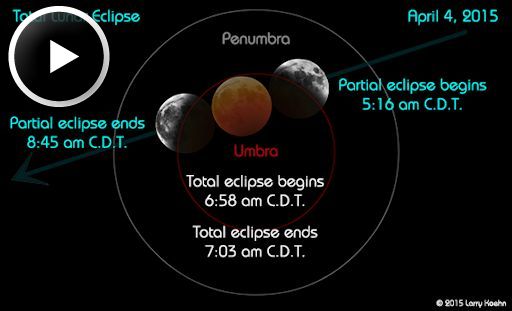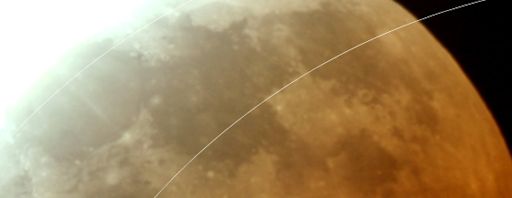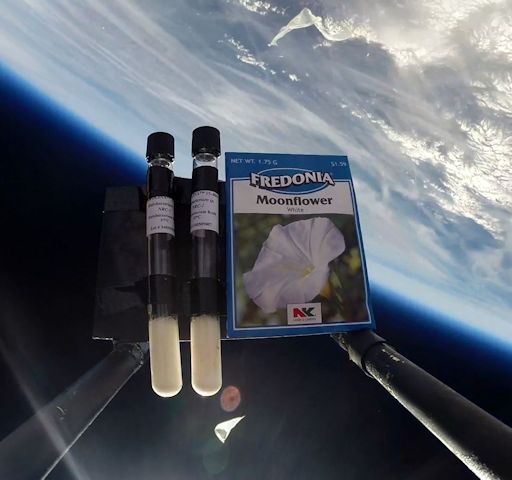Come to Tromsø and share Marianne's passion for rural photography: Chasethelighttours.co.uk invites you to experience "Heaven on Earth" with an aurora, fjord, fishing, whale watching, photography or sightseeing tour. | | |
TOTAL ECLIPSE OF THE MOON: On Saturday morning, April 4th, the shadow of the Earth will fall across the Moon, turning the lunar disk a beautiful shade of celestial red. The total eclipse will be visible from the Americas, the Pacific Ocean, Australia, New Zealand and eastern parts of Asia. Click to preview the Moon's colorful transformation:

Some total eclipses last for more than an hour. In this case, however, totality spans just 4 minutes and 43 seconds—a result of the fact that the Moon is skimming the outskirts of Earth's shadow rather than passing centrally through it. The brevity of the eclipse highlights the importance of watching the clock: Be outside no later than 4:58 AM PDT (11:58 UT) to witness the red Moon.
Why red?
A quick trip to the Moon provides the answer: Imagine yourself standing on a dusty lunar plain looking up at the sky. Overhead hangs Earth, nightside down, completely hiding the sun behind it. The eclipse is underway. You might expect Earth seen in this way to be utterly dark, but it's not. The rim of the planet looks like it is on fire. As you scan your eye around Earth's circumference, you're seeing every sunrise and every sunset in the world, all of them, all at once. This incredible light beams into the heart of Earth's shadow, filling it with a coppery glow and transforming the Moon into a great red orb when viewed from Earth.
Red is not the only color, however. Sometimes observers spot a subtle band of turquoise:

This is the "ozone fringe." Atmospheric scientist Richard Keen of the University of Colorado explains: "Most of the light illuminating the Moon passes through the stratosphere, and is reddened by scattering. However, light passing through the upper stratosphere penetrates the ozone layer, which absorbs red light and actually makes the passing light ray bluer." This can be seen using binoculars or a small telescope as a turquoise border around the red. Be alert for both colors on Saturday morning!
Realtime Eclipse Photo Gallery
MARS MICROBES AND MOON FLOWERS: Astrobiologists have long wondered if halobacteria, a terrestrial extremophile with a special talent for shielding itself from UV radiation, could survive on the planet Mars. To find the answer, the students of Earth to Sky Calculus have been flying halobacteria onboard balloons to the top of Earth's atmosphere. On April 1st, these samples reached an altitude of 110,500 feet:

During the flight, onboard sensors registered temperatures as low as -58 C, air pressures of 1% sea level, and cosmic radiation levels 40 times Earth-normal. Those are conditions akin to the planet Mars. Two and a half hours after they were launched, the bacteria landed near the Eureka Dunes in Death Valley National Park. This means they experienced a 120 C swing in temperature, a 100-fold change in air pressure, and a 40-fold surge of radiation.
Back in 2014, the students proved that halobacteria could survive a single trip to the stratosphere. The current experiment pushes the envelope by flying halobacteria multiple times. One of the test tubes pictured above has already been to the edge of space on March 24th. The microbes in hat tube will be stress-tested a third time with a balloon flight on April 7th. How tough are halobacteria? Stay tuned.
In addition to halobactera, the students also flew a variety of seeds including Moon flowers (shown above), Jupiter beets, sunflowers, jalapeno peppers, cherry tomatoes, cosmos flowers, corn and carrots. While they traveled to the top of the atmosphere, control packets remained behinnd on Earth. It's an instant science fair project! If you would like some "space seeds" for your own experimentation or just-for-fun gardening, you may have a pair of packets (control+flown) for $49.95. Contact Dr. Tony Phillips to place your order. All proceeds support student research.
THE SOLAR WIND HAS ARRIVED: As predicted, a solar wind stream hit Earth's magnetic field during the late hours of April 2nd. The initial impact did not spark a geomagnetic storm. However, geomagnetic storms could develop on April 3rd as Earth moves deeper into the stream. High-latitude sky watchers should be alert for auroras. Aurora alerts: text, voice
Realtime Space Weather Photo Gallery
Realtime Aurora Photo Gallery
Realtime Comet Photo Gallery
Every night, a network of NASA all-sky cameras scans the skies above the United States for meteoritic fireballs. Automated software maintained by NASA's Meteoroid Environment Office calculates their orbits, velocity, penetration depth in Earth's atmosphere and many other characteristics. Daily results are presented here on Spaceweather.com.
On Apr. 3, 2015, the network reported 2 fireballs.
(2 sporadics)

In this diagram of the inner solar system, all of the fireball orbits intersect at a single point--Earth. The orbits are color-coded by velocity, from slow (red) to fast (blue). [Larger image] [movies]
Potentially Hazardous Asteroids (
PHAs) are space rocks larger than approximately 100m that can come closer to Earth than 0.05 AU. None of the known PHAs is on a collision course with our planet, although astronomers are finding
new ones all the time.
On April 3, 2015 there were potentially hazardous asteroids.
Notes: LD means "Lunar Distance." 1 LD = 384,401 km, the distance between Earth and the Moon. 1 LD also equals 0.00256 AU. MAG is the visual magnitude of the asteroid on the date of closest approach. | | The official U.S. government space weather bureau |
| | The first place to look for information about sundogs, pillars, rainbows and related phenomena. |
| | Researchers call it a "Hubble for the sun." SDO is the most advanced solar observatory ever. |
| | 3D views of the sun from NASA's Solar and Terrestrial Relations Observatory |
| | Realtime and archival images of the Sun from SOHO. |
| | from the NOAA Space Environment Center |
| | the underlying science of space weather |

